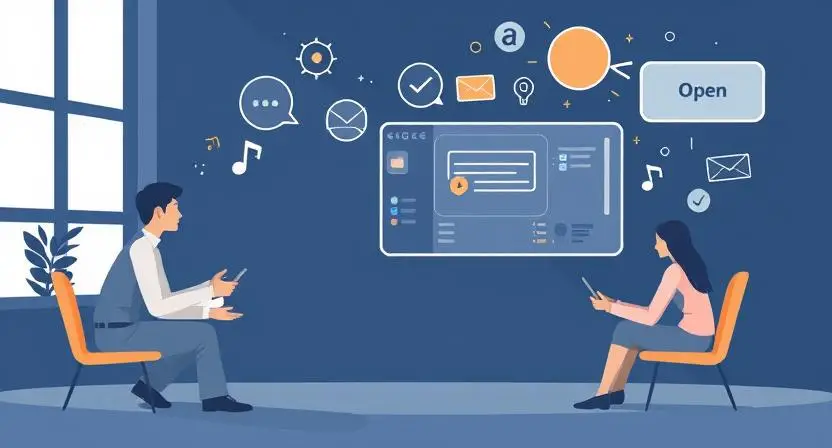Trust serves as the cornerstone of every meaningful relationship, be it in personal connections or professional partnerships. When trust is broken, rebuilding it can seem like a daunting task. However, one of the most effective ways to restore trust is through open communication. Open communication fosters transparency, honesty, and mutual understanding, all of which are essential for rebuilding the trust that may have been lost.
In this article, we’ll explore how open communication can help rebuild trust, the steps you can take, practical tools for fostering dialogue, and how to overcome challenges along the way.
Why Open Communication is Key to Rebuilding Trust
When trust is broken, it’s often due to a lack of clear and honest communication. In relationships where communication is poor, assumptions and misunderstandings flourish, causing further rifts. Open communication allows for transparency, where both parties can express themselves freely and honestly, leading to a deeper understanding of each other’s feelings and perspectives.
The Role of Honesty in Restoring Relationships
Honesty is the cornerstone of trust. When you are open and truthful about your actions, intentions, and emotions, it helps the other person see that you are genuine in your efforts to rebuild the relationship. Being honest doesn’t just mean sharing the good news it also involves sharing the bad, owning up to mistakes, and expressing vulnerability.
How Miscommunication Breaks Trust
Miscommunication often leads to assumptions, which can snowball into misunderstandings. When people fail to express themselves clearly or listen to each other, the gaps in understanding deepen. This can cause hurt feelings, resentment, and frustration, which erode trust. The more often miscommunication occurs, the more difficult it becomes to rebuild trust.
Real-Life Examples of Trust Broken by Poor Communication
Consider the scenario of a manager who doesn’t clearly communicate expectations to their team. As a result, employees are unsure about their roles, leading to mistakes that could have been avoided with clear communication. Over time, this lack of clarity damages the team’s trust in the manager’s leadership. Similarly, in personal relationships, not discussing important issues, such as finances or personal boundaries, can result in feelings of betrayal and disillusionment.
The Psychological Impact of Open Dialogue on Trust
Open dialogue has a powerful psychological impact. It can reduce anxiety, clarify misunderstandings, and create a sense of safety and security. When people feel heard and understood, they’re more likely to feel that their needs are being considered, which is vital in rebuilding trust. In the absence of communication, people may create negative narratives in their minds, which only fuels mistrust.
Steps to Rebuild Trust Through Open Communication
Rebuilding trust requires intentional effort. Here are actionable steps to guide you in using open communication to restore trust:
Acknowledge the Issue and Take Responsibility
Before moving forward, it’s crucial to acknowledge that trust has been broken. Taking responsibility for your actions, or acknowledging the issue at hand, sets the stage for rebuilding.
Why Owning Up to Mistakes Matters
Owning up to mistakes demonstrates accountability and sincerity. It shows the other person that you are aware of the impact of your actions and that you are committed to making things right. Avoiding blame or making excuses will only prolong the healing process.
How to Apologize Sincerely
A sincere apology involves expressing regret for your actions, acknowledging the hurt caused, and offering a plan to make amends. It’s important that the apology comes across as genuine, without trying to justify your actions or shifting responsibility. Make sure the person knows that their feelings are valid and that you’re committed to improving.
Practice Active Listening
Active listening is essential for effective communication. It’s not just about hearing words; it’s about understanding the speaker’s feelings, concerns, and needs. When people feel listened to, they feel valued, which is key to restoring trust.
Techniques for Effective Listening
- Repeat or rephrase the other person’s words to confirm you’ve understood them correctly.
- Refrain from interrupting and allow the other person to fully express themselves before you reply.
- Show empathy by acknowledging their emotions.
- Ask clarifying questions to demonstrate genuine interest.
How Listening Builds Emotional Connection
By practicing active listening, you not only show respect but also create a safe space where the other person feels understood. This emotional connection is a key component in rebuilding trust because it signals that both parties are invested in the relationship.
Be Transparent and Consistent
Transparency involves sharing information openly, while consistency means following through on your commitments. When you’re transparent, you reduce the chances of misunderstandings. Consistency, on the other hand, helps reassure the other person that you are reliable and trustworthy.
The Importance of Transparency in Rebuilding Trust
Transparency removes ambiguity. When you share your thoughts and intentions openly, the other person doesn’t have to guess what you mean or wonder about your motives. This clarity helps build confidence in the relationship.
How Consistency Reinforces Reliability
Consistency is a key element in rebuilding trust. By following through on your promises and commitments, you demonstrate that you can be relied upon. Consistency in behavior, communication, and actions helps the other person feel secure and hopeful about the relationship’s future.
Set Clear Expectations and Boundaries
Clear expectations and boundaries help define what is acceptable and what is not in the relationship. Without clear communication of these limits, people can easily feel betrayed or hurt by unexpected actions.
Why Boundaries Are Essential for Trust
Boundaries are vital for maintaining respect and preventing misunderstandings. They help both parties understand each other’s needs and limits, which is crucial for trust. Without boundaries, it’s easy to overstep, leading to feelings of betrayal.
How to Communicate Expectations Effectively
Be explicit about your needs and listen to the other person’s. For example, if one person values personal space, it’s important to communicate this need clearly and respect the other’s boundaries. This helps ensure that both parties are on the same page and can prevent future breaches of trust.

Tools and Strategies to Foster Open Communication
There are several tools and strategies you can employ to make open communication more effective:
Using “I” Statements to Express Feelings
“I” statements help avoid blaming language and focus on expressing your feelings without accusing or criticizing. For example, instead of saying “You never listen to me,” you might say, “I feel unheard when my concerns aren’t addressed.” This promotes a more constructive conversation.
Examples of "I" Statements in Action
- “I feel frustrated when I don’t receive timely updates.”
- “I need space to process my feelings before we talk further.”
Scheduling Regular Check-Ins
Regular check-ins help maintain ongoing communication and prevent issues from piling up. Scheduling time to talk, whether daily or weekly, ensures that both parties stay on the same page and issues are addressed promptly.
How Frequent Communication Prevents Misunderstandings
Frequent communication helps to address concerns before they grow into larger issues. Regular check-ins can also help reinforce trust by providing an ongoing opportunity for transparency and honest exchange.
Leveraging Technology for Better Communication
There are several apps and tools designed to improve communication, whether in personal or professional settings. Tools like Slack, Zoom, or even simple messaging apps allow for quick and efficient communication, especially in situations where face-to-face meetings may not be possible.
Best Apps and Tools for Open Dialogue
- Slack: Excellent for team communication, keeping everyone informed in real-time.
- Zoom: Facilitates face-to-face communication, even remotely.
- Therapist platforms: Useful for guided conversations in therapy or mediation.
Overcoming Challenges in Rebuilding Trust
Rebuilding trust is not without its challenges, but with the right approach, these obstacles can be overcome.
Dealing with Resistance to Open Communication
Some people may resist open communication, either due to fear, past experiences, or distrust. In such cases, it’s important to remain patient and empathetic, encouraging dialogue in a non-confrontational manner.
How to Handle Defensiveness in Conversations
Stay calm and composed when the other person becomes defensive. Avoid escalating the situation and focus on de-escalating the tension by validating their feelings and offering empathy.
Rebuilding Trust After Betrayal
Betrayal, whether it’s infidelity or dishonesty, can make rebuilding trust particularly difficult. The key here is to acknowledge the betrayal, express genuine remorse, and take steps to make amends over time.
Steps to Heal After a Major Breach of Trust
- Acknowledge the pain: Recognize the emotional impact of the betrayal.
- Make reparations: Take steps to correct your behavior.
- Give time and space: Healing takes time, so be patient.
Patience and Persistence in the Process
Trust doesn’t rebuild overnight. It requires consistent effort, patience, and a commitment to the process. Understand that there will be setbacks, but the more consistent you are in your communication and actions, the stronger the relationship will become.
Why Trust Takes Time to Rebuild
Trust is fragile, and it takes time to earn back. Consistency and patience are key showing that you can be relied upon over time will help the person feel secure in trusting you again.
Conclusion: The Long-Term Benefits of Open Communication
Rebuilding trust through open communication is a long-term investment in any relationship. By being honest, transparent, and consistent, you not only restore trust but also strengthen the bond. Open communication fosters understanding, deepens emotional connection, and cultivates mutual respect vital components of any successful relationship.
How Open Communication Strengthens Relationships
Open communication strengthens relationships by creating a safe environment for both parties to express themselves. It reduces misunderstandings, minimizes conflicts, and builds a foundation of trust.
Final Tips for Maintaining Trust Over Time
- Keep communication consistent: Don’t wait for issues to arise keep the conversation going.
- Be patient: Trust takes time, so be patient with both yourself and the other person.
- Stay committed: Be consistent in your efforts, and trust will follow.
By following these practices, you can rebuild and maintain trust in your relationships for the long term.
FAQs: Rebuilding Trust Through Open Communication
1. Why is open communication important for rebuilding trust?
Open communication is essential because it fosters honesty, transparency, and understanding. When people communicate openly, they can address misunderstandings, express their feelings, and work together to resolve issues. This creates a foundation of reliability and emotional safety, which are critical for rebuilding trust.
2. How long does it take to rebuild trust through open communication?
Rebuilding trust is not an overnight process. The time it takes depends on the severity of the breach, the willingness of both parties to communicate openly, and their commitment to the process. While small issues may be resolved quickly, deeper betrayals can take months or even years to heal.
3. What are some examples of open communication in action?
Examples of open communication include:
- Admitting mistakes and apologizing sincerely.
- Actively listening without interrupting or judging.
- Sharing thoughts and feelings honestly, even when it’s uncomfortable.
- Setting clear expectations and boundaries to avoid future misunderstandings.

